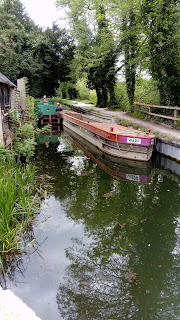The Boat Team
Here are a few snippets from my week in the Boat Team.
Monday was the date of the first of two forums that are being held for the Boat Team. Every aspect of life on the canal has change over the last year or two and those changes have been reflected in the Boat Team. We felt it was time to reflect on exactly what that means for the Boat Team and its volunteers. Along with Dave and myself 16 volunteers came along to see what it was all about. That was a wonderful turnout. Also attending was Reg Gregory, our Maintenance Director who was tempted along by the promise of tea and biscuits. Many things were discussed over about a three hour period and just about all comments received were very favourable. The proceedings were completed by a short course on rope work, admirably presented by Tony Jones.

Tuesday, I’ve had reports that Goliath was out training with Tony with Chris and Steve. Unfortunately this coincided with some water problems in Ryeford pound, grounding Goliath. So, they spent the day with the outboard on Aquila, which can navigate in a puddle.
Wednesday found me at 9:00 am preparing to assess two of our skippers for their Margaret with hoppers endorsement. For those who don’t know, your basic training in the Boat Team gives you a ticket to command Goliath in all its operations along with some small boat authority. But to drive anything else we operate a system of endorsements. With boats as diverse and complicated as Weedie, Margaret and Wookey Hole, you cannot just jump from one to the other without some serious familiarisation. I’m happy to report that Rob Wilson and Ian Nie are now fully fledged skippers on Margaret. Floyd Baker was along too, to make sure it was all done right.
Managing to split myself in two, I also spent some time with the Wookey crew. In theory, they were without a skipper for the boat, so I went along to make sure it could be moved. I was quite astonished by two things that day. The first was that Richard Tanner volunteered to be a boat skipper!!!!
The proof is here. Something a lot of people never expected to see. Well we put him through his paces, and straight off the wharf he executed a perfect 180 to proceed Eastwards. That’s a pass then. Not that Richard really needs a formal assessment. If anyone has grandfather rights on Wookey it is him. Seriously, we’re very grateful to him for agreeing to step in as skipper when needed. Jerry Caesar then did a very passable job of taking Wookey onto its new mooring. Just a few formalities and he will have his WRG 21b on Wookey.
The second thing that astonished me was that an awful lot of the work on Wookey is done by the girls in the team, which is where most of the physical work of the Boat Team is done. Come on fellers, they’re showing you up. I also suspect they had some influence in persuading Richard to drive the boat. It was a real pleasure to work with Heather and Rachel.
Other in the team were messing about up above Dudbridge. The pound was lowered to take a good look at the gas main obstruction and also the leak on the lower gates of Wallbridge Lower. I don’t have much detailed knowledge of how they got on.
All things considered, a very good week. I wonder what next week will bring.



















































